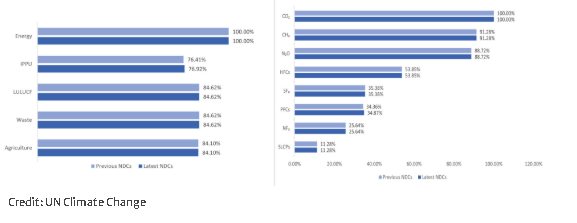Parties provided information on mitigation targets as well as mitigation co-benefits resulting from adaptation actions and/or economic diversification plans. The mitigation targets range from economy-wide absolute emission reduction targets to strategies, policies, plans and actions for low-emission development. In their NDCs:
Types of mitigation target and share of Parties that communicated them in nationally determined contributions

Sectors and greenhouse gases covered by Parties that communicated them in nationally determined contributions

A total of 93 per cent of Parties communicated an NDC implementation period of until 2030, while 7 per cent specified an implementation period of until 2025, 2035, 2040 or 2050. While 54 per cent of Parties identified 1 January 2021 as their starting date for NDC implementation, 29 per cent indicated that they started implementing their NDC in or before 2020 and 6 per cent mentioned starting implementation in 2022.
In addition, 96 per cent of Parties provided quantified information on their mitigation targets and reference points. Of the Parties that submitted new or updated NDCs, 84 per cent updated the basis for defining their targets, including reference points and/or ‘business as usual’ scenarios. Such updates lead to higher-quality NDCs and, for some Parties, to significant changes in the estimated emission levels for 2025 and 2030.
Share of Parties indicating in nationally determined contributions the intention to use or possibility of using specific scopes of voluntary cooperation under Article 6 of the Paris Agreement

A total of 78 per cent of Parties stated that they plan to or will possibly use at least one type of voluntary cooperation under Article 6 of the Paris Agreement. Use of cooperative approaches referred to in Article 6, paragraph 2, was most frequently communicated (by 52 per cent of Parties), followed by use of the mechanism established by Article 6, paragraph 4, (34 per cent) and general use of voluntary cooperation (25 per cent).
At Eco Datalytics, we utilize advanced satellite imagery and remote sensing tools, to monitor environmental changes in real-time, track GHG emissions, assess land use, and detect climate anomalies
Who Are We
Our Mission
Home
Sectorial Analysis
Key Visulizations
COP 30
Latest Reports

© 2025 Ecodatalytics